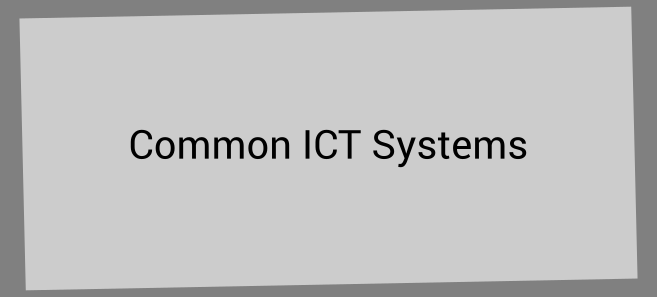Many Common ICT Systems have different functions, of which they have names. All businesses, schools and organisations will often require some computer system, even registration or time management. However often these systems are financially concerned and for that reason are often automated.

Legacy Systems
Maintain the older applications for customers who still use them. They are maintained until they become depreciated and service systems that are older or out of date. It is likely that this system has been used for a long time and it would be impractical to upgrade without replacing it being expensive, disruptive or not worthwhile. Financial systems may keep their systems records for significantly longer amounts of time than other departments to monitor progress etc.
Back office systems
Maintain the business itself. They are situated elsewhere from the front-facing aspects of a business and whose role it is to keep the business working effectively. A back-office system resides in a ‘back office’ and as such doesn’t usually interact with any customers. The goal of back office systems like finance and IT is to service the other departments of the business and keep the business running effectively.
Day-to-day working systems
A transaction processing system
A system that manages and maintains the records of transactions and payments, they crucially have to be up-to-date at any time. Often on large-scale systems, this can be difficult to keep accurate, so caching is used.
Document approval workflow
A Document approval workflow system ensures that a document is suitably acceptable to carry out a procedure by going through the necessary stages from person to person, the way that the workflow works to ensure that the document is compliant with any standards or higher-up individuals before the aim of the document is carried out.
Document management system
A Document Management System allows for the distribution and long-term archiving of documents that are to be held long term.
Management Information Systems
A MIS allows a manager of a department to oversee and manage the use of a system without having to obtain the information manually, it collects and maintains the data from systems in order to allow the manager to perform a task, It also allows them to see side-by-side a comparison based on previous data for example.
Enterprise Resource Planning Systems
Enterprise management tools allow businesses to effectively coordinate staff and assets to complete business projects and task to a deadline and manage day to day running of systems such as a Gantt chart. Often enterprise systems can encompass many business operations from stock management to re-ordering, transit, delivery, management and season planning. Some business locations may be run completely centrally where business operations of a franchise are handled entirely by the main offices.
Customer Relationship Management Systems
Customer relationship management systems allow businesses to track the status of a customer and their relationship with the company, similar to a ticket system it allows them to identify when they need to contact a customer about an expiring contract or maintain effective communication between an employee and customer.
Decision Support Systems
Decision support systems guide employees on how to handle a task based on set data that they have to evaluate to reach a conclusion, sometimes these solutions can be convolutional so a decision support system allows them to make the right choice.
E-commerce systems
An e-commerce system allows them to track the online progress of an online sale and provide a front-end shop for customers to browse and a back end stock management and sometimes other facilities like AB testing.